Forget Fish And Chips: Cheesy Parmo Is Fried Pub Fare At Its Finest
Regional dishes have a huge impact on culture and communities. They contribute as much to identity as songs, flags, or odd traditions and often tell an interesting tale going back decades, at the least. Some, like Poland's zapiekanka, are borne of necessity; food scarcity causes people to get creative with ingredients and cooking methods. Conversely, Italy's margherita pizza — with its red, white, and green toppings — is designed to sum up the country as a whole.
The regional dish where I'm originally from is the "parmo." It's a wide, flat, fried chicken, pork, or veal disk doused in bechamel sauce and cheese and then grilled so the toppings melt together. Despite the name, the cheese in question isn't parmesan. Instead, it's whatever mild yellow cheese blend that restaurants in the area also use for pizza. Chicken is the most popular protein, a few prefer pork, and the veal edition is essentially extinct these days.
Parmo is characteristically served in a pizza box and is eaten as an evening meal pretty often, but its reputation has been built on the fact that it's a great choice when you've had a lot to drink and need something both filling and outlandishly greasy. Despite all of this, I would argue it ticks all of the boxes of cultural food and deserves as much respect and recognition as a Philly cheesesteak, traditional jambalaya, or poutine. It may be a little rough around the edges, but that in itself is part of the charm.
There have been attempts to make it respectable
At several points in the parmo's history, there have been attempts to make a classier version that will win the approval of people who the dish doesn't need approval from in the first place. These attempts to gentrify the parmo often involve a massively reduced portion size, the upscaling of ingredients, and the inclusion of actual parmesan cheese.
It's both sad and insulting when this happens. All of the dish's charm is stripped, and it just becomes another flyover menu item that people might acknowledge before scanning past to order the duck anyway. I would argue there is nothing wrong with the parmo like it is; it would take a truly brave chef to abandon attempts at replacing the breadcrumb crust with freshly made croutons and choose instead to slap a large, greasy pizza box in front of their diners.
Trying a regional dish is like having a little tour of the area, and tours that are glossed over or made to tick certain boxes tend to be boring and awful. You want authenticity, you want the real thing. It should really be the same with food. If you're giving diners an opportunity to try it, let them try the dish itself — not some overthought interpretation of it that, when you scratch beneath the surface, feels more generic than anything.
It can be classy, if done the right way
All of this is not to say the parmo doesn't belong in a restaurant. It was actually born in one, owing origin to a Greek man called Nico Harris, who served with American forces in WWII before settling in Middlesbrough and creating the region's favorite high-calorie treat. His restaurant, the Europa, sat on Borough Road for decades but has sadly now closed. If Harris' creation did get the global recognition it deserves, the Europa would certainly have been a pilgrimage for parmo heads worldwide.
While most people might be used to seeing a parmo in a pizza box, there are some very good restaurant renditions where you can arguably have your best parmo experience. So how do you actually upscale a parmo? You just cook the same meal but without cutting corners. The chicken should be fresh. Still hammered out, but not razor thin — a nice juicy bite. Add plenty of bechamel sauce, and boom. Diners have a true-to-the-original experience, and a good one at that, while the restaurant offers something you're not going to find in the majority of kebab shops.
A few restaurants have carved out their own reputations. The Open Jar has several locations in the region, and its parmos have been a great experience every time I've frequented the Hartlepool branch. Central Park in Middlesbrough is another solid choice, and village pubs with a reputation for food, like The Blue Bell in Yarm, tend to offer a fantastic parmo.
So, why does it deserve recognition?
As mentioned, the parmo ticks all of the boxes when it comes to iconic regional foods. It's unique and well-loved in its place of origin. The local newspaper has a parmo section to keep locals abreast with the latest parmo happenings. If you mention it to anyone from the region, their faces usually light up, and they're happy to talk about this key part of Teesside culture.
But most of all, the parmo deserves a bit of recognition because, like other regional foods, it shines a spotlight on a region that has contributed a lot to the world without receiving much acknowledgment for its efforts. Food's a great way to spread culture, and you can tour a continent without leaving the dinner table.
That recognition has been slowly coming, but interest in the dish may have boomed in recent years. It's appearing on restaurant menus in far-flung locations — and parmo "eating challenges" have attracted several popular YouTubers to the region. This is all brilliant for the parmo's reputation, as it makes people want to try it. However, if you really do want to get one — it might be worth booking a flight to Teesside.
If you want to try it, you'll need to make a trip
The parmo is actually available worldwide to some degree, mainly due to former residents of the North East moving around the globe. There are offerings as far afield as New York, Australians have their own take on it, and you can even get one in "that London." The issue is the further you get from Middlesbrough, the greater the drop in quality you'll experience. This is probably another tick in the authentic regional dish box. If you ask someone from Philly what the cheesesteak in your local diner is like, you'll probably get a look of disgust.
With the parmo, even going 30 miles or so up the A19 to Sunderland will land you in trouble. I tried one there while at university and abandoned it two bites in. They'd done the Australian thing and replaced the bechamel with marinara sauce. Further up the road in Newcastle, they seemingly hadn't bothered with sauce at all, and the chicken was very dry. If you're intent on trying a parmo, Middlesbrough is probably your best bet though very good attempts can be found in Hartlepool, Darlington, Durham, and Stockton. If you're anywhere beyond that, you should probably roll the dice and attempt to make your own — though results may vary.




